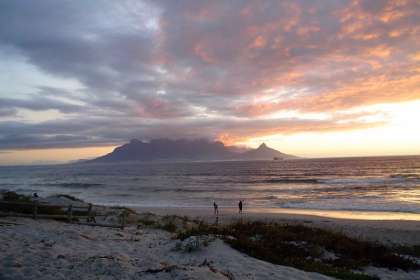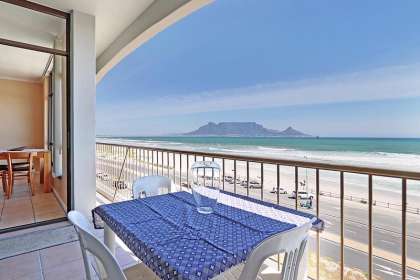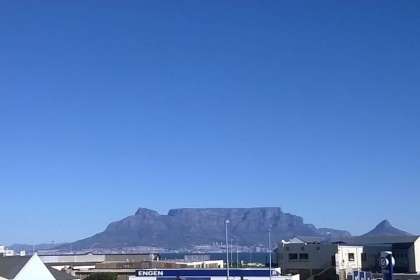Table Bay - Cape Town, Western Cape
- Port of Cape Town - Western Cape (3.74km)
- Cape Wheel - V&A Waterfront, Cape Town (4.05km)
- Granger Bay Harbour - Cape Town (4.19km)
- Cape Town Diamond Museum - V&A Waterfront (4.28km)
- Oranjezicht City Farm Market - V&A Waterfront, Cape Town (4.29km)
- Silo District - V&A Waterfront, Cape Town (4.34km)
- Zeitz Museum of Contemporary Art Africa - Cape Town (4.41km)
- New Somerset Hospital - Green Point, Cape Town (4.45km)
- Watershed - V&A Waterfront, Cape Town (4.47km)
- Cape Town International Film Market & Festival (CTIFMF) (4.55km)
- Two Oceans Aquarium - Cape Town (4.60km)
- Cape Medical Museum - V&A Waterfront, Cape Town (4.60km)
- Metropolitan Golf Club - Green Point, Cape Town (4.62km)
- Milnerton Golf Course - Woodbridge Island, Cape Town (4.64km)
- Cape Town Stadium - Green Point, Cape Town (4.64km)
- Milnerton Lighthouse - Milnerton, Cape Town (4.66km)
- Milnerton Flea Market - Cape Town (4.68km)
- Green Point Market - Cape Town (4.85km)
- Cape Town International Convention Centre (4.89km)
- Cape Gourmet Festival - Cape Town (4.89km)
Table Bay - Cape Town, Western Cape
Although the Cape was first explored by Bartolomeu Dias in the late 1400's it was on in 1652 that Cape Town was founded by the Dutch explorer, Jan Van Riebeek. And during this period the natural bay on the west coast of South Africa, just north of the Cape Peninsula, was named Table Bay. The bay was named after one of the country's most well know landmarks, Table Mountain.
Table Bay was one of the few places along the west coast that could harbour ships, but during the 17th and 18th many of the ships that were anchored in the bay were driven ashore by storms. The bay offers, little if any protection from the gale force winds which batter the coastline from both the South East and the North West. The Dutch however continued to use the bay as the other options were not viable at the time. Saldanha Bay which was much further up the West Coast was a good option but had no fresh water, and closer to Table Bay the other two options, Simon's Town and Hout Bay were harder to access at the time and only slightly more protected than Table Bay itself.
In 1858 a serious storm blew 30 ships ashore, completely wrecking them and killing many sailors. It reached a point where the British company, Lloyd's of London, refused to insure any ships in Table Bay during the winter months. It was this move that almost forced the British Colonial Government to start construction of the first breakwater in 1860. This over the years became the Victoria and Alfred Basin, Table Bay's first safe harbour. Today the Victoria and Alfred Waterfront preserves parts of the harbours history.
Table Bay also has a very important feature, especially to South African History. Robben Island can be found in the waters of Table Bay, the island where former president Nelson Mandela was imprisoned for decades. The Island is visible from shore or can be visited using the Robben Island Museum Tour.
Here are five interesting facts about Table Bay in Cape Town:
1. Historical Significance: Table Bay has played a crucial role in maritime history since the 15th century. It served as a vital stopover point for European ships traveling to the East Indies. The Dutch East India Company established a refreshment station here in 1652, which later grew into the city of Cape Town.
2. Iconic Backdrop: The bay is framed by the stunning Table Mountain, one of the most recognizable landmarks in the world. The flat-topped mountain provides a dramatic backdrop to the bay and the city.
3. Robben Island: Located in Table Bay, Robben Island is famous for being the site where Nelson Mandela was imprisoned for 18 years. The island is now a UNESCO World Heritage Site and museum, attracting numerous visitors annually.
4. V&A Waterfront: The Victoria & Alfred Waterfront, situated in Table Bay, is one of South Africa's most visited tourist attractions. It offers a mix of shopping, dining, entertainment, and cultural experiences, along with scenic views of the harbor and Table Mountain.
5. Diverse Marine Life: The waters of Table Bay are rich in marine biodiversity. It is a common sight to see dolphins, seals, and occasionally whales in the bay. The area is also popular for recreational activities such as sailing, kite surfing, and fishing.
Accommodation Near Table Bay - Cape Town, Western Cape
8 Neptune's Isle
Self Catering Apartment, Flatlet Accommodation in Milnerton
4.6km from Table Bay - Cape Town, Western CapeNeptune's Isle cabana (sleeps 4) is a great getaway for pleasure seeking tourists, or for a weekend break. Self-catering - Cabana is situated on the edge of the Atlantic Ocean with views of Table Mountain & Robben Island across the bay, and from where... …see more for bookings / enquiries and info.
Beach Villa
Self Catering Apartment, Flatlet Accommodation in Mouille Point
4.7km from Table Bay - Cape Town, Western CapeBeach Villa apartment provides self catering accommodation in Mouille Point, Cape Town City Bowl. Beach Villa, is a spacious two bedroomed self catering apartment with stunning sea and mountain views and within walking distance to the Mouille Point beach …see more for bookings / enquiries and info.
Witsand 103
Self Catering Apartment, Flatlet Accommodation in Bloubergrant
5.9km from Table Bay - Cape Town, Western CapeThis spacious two-bedroom apartment accommodates four persons and is situated on the first floor of a nine-floor apartment block with easy access by elevator or stairs. It offers un-obstructed and superb views of Table Bay, Table Mountain and... …see more for bookings / enquiries and info.
Sea Breeze
Self Catering Apartment, Flatlet Accommodation in Bloubergrant
6km from Table Bay - Cape Town, Western CapeSea Breeze (sleeps 4) apartment provides self catering accommodation in Bloubergrant, Bloubergstrand, Cape Town. From the lounge, main bedroom and balcony you have the most spectacular views of the Bloubergrant beach, ocean, Table Mountain, Cape Town... …see more for bookings / enquiries and info.
Green Point Self Catering Studio
Self Catering Apartment, Flatlet Accommodation in Green Point, Cape Town
6km from Table Bay - Cape Town, Western CapeGreen Point Self Catering Studio provides visitors with self catering accommodation in Green Point, Cape Town City Bowl. We offer 2 self catering studios. Green Point Self Catering Studio 1 (sleeps max two) is a tastefully renovated self-catering studio.. …see more for bookings / enquiries and info.
Aandvari Zeezicht
Self Catering Apartment, Flatlet Accommodation in Bloubergstrand
6km from Table Bay - Cape Town, Western CapeAandvari Zeezicht right on the beach offering self catering accommodation (sleeps 5) in Bloubergrant, Bloubergstrand, Cape Town. Aandvari Zeezicht - an elegant, two bedroomed apartment, in the heart of Cape Town's beautiful Blouberg. …see more for bookings / enquiries and info.
Sea View Zeezicht
Self Catering Apartment, Flatlet Accommodation in Bloubergstrand
6km from Table Bay - Cape Town, Western CapeThis beachfront self-catering apartment is located in Bloubergstrand on the beautiful Atlantic Coast, with stunning sea and mountain views. The beach is famous for water sports on its endless white sand, and is situated between Dolphin Beach... …see more for bookings / enquiries and info.
Aandvari Ocean View
Self Catering Apartment, Flatlet Accommodation in Bloubergrant
6.1km from Table Bay - Cape Town, Western CapeLocated on Blouberg's beautiful beachfront is Aandvari Ocean View, a modern and luxurious sea-facing studio apartment, perfectly suited to honeymoon accommodation, special getaways, up market business accommodation or for a fun seaside holiday... …see more for bookings / enquiries and info.
Aandvari Sunset Court
Self Catering Apartment, Flatlet Accommodation in Bloubergrant
6.1km from Table Bay - Cape Town, Western CapeNestling merely a stroll away from the beachfront in Cape Town's beautiful Blouberg is Aandvari, a hidden gem. This elegantly furnished and tastefully decorated penthouse apartment enjoys magnificent views of Table Mountain and the sea. …see more for bookings / enquiries and info.
Blue Flamingo B&B
Bed & Breakfast Accommodation in Table View
6.5km from Table Bay - Cape Town, Western CapeBlue Flamingo Bed & Breakfast offers peaceful, comfortable accommodation in the quiet, safe northern coastal suburb of Table View, in Cape Town, the mother city of South Africa. …see more for bookings / enquiries and info.
- Port of Cape Town - Western Cape (3.74km)
- Cape Wheel - V&A Waterfront, Cape Town (4.05km)
- Granger Bay Harbour - Cape Town (4.19km)
- Cape Town Diamond Museum - V&A Waterfront (4.28km)
- Oranjezicht City Farm Market - V&A Waterfront, Cape Town (4.29km)
- Silo District - V&A Waterfront, Cape Town (4.34km)
- Zeitz Museum of Contemporary Art Africa - Cape Town (4.41km)
- New Somerset Hospital - Green Point, Cape Town (4.45km)
- Watershed - V&A Waterfront, Cape Town (4.47km)
- Cape Town International Film Market & Festival (CTIFMF) (4.55km)
- Two Oceans Aquarium - Cape Town (4.60km)
- Cape Medical Museum - V&A Waterfront, Cape Town (4.60km)
- Metropolitan Golf Club - Green Point, Cape Town (4.62km)
- Milnerton Golf Course - Woodbridge Island, Cape Town (4.64km)
- Cape Town Stadium - Green Point, Cape Town (4.64km)
- Milnerton Lighthouse - Milnerton, Cape Town (4.66km)
- Milnerton Flea Market - Cape Town (4.68km)
- Green Point Market - Cape Town (4.85km)
- Cape Town International Convention Centre (4.89km)
- Cape Gourmet Festival - Cape Town (4.89km)











